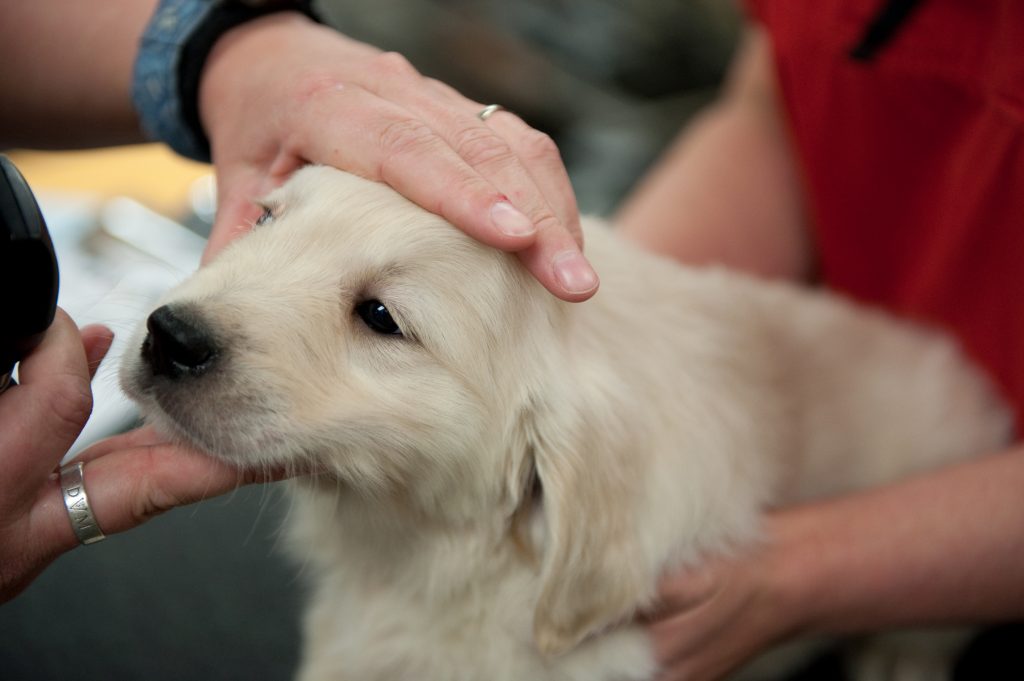As your other family doctor, I dream of a day when I can walk into an exam room and have my patient tell me what they are feeling and when they began feeling it. It is a challenge that is exclusive to veterinary medicine, and which highlights the importance of a physical examination. The reality is – as much as we’d like to be, we can’t all be Dr. Dolittle! Animals cannot convey pain or discomfort to us with words, therefore taking a closer look, extending or flexing a leg, palpating an abdomen or listening to a chest may be the only way to get the information we need in order to make a diagnosis.
Each body system has an associated in-depth examination depending on the presenting complaint. If the pet is limping, a full orthopaedic exam additional to the regular basic examination is warranted. If the ears are bothersome, a complete otoscopic exam is required to assess the ear canals for discharge and/or pain. If the pet is disoriented and loses function of certain normal abilities such as standing, walking or holding urine or feces, an in-depth neurological exam is necessary. This is one of the many reasons why a physical exam is so very important – the presenting complaint allows us to tailor our exam to the needs of the patient. It is this flexibility and adaptability of the examination process that enables us to often quickly localize the cause of the problem.
So where do we start? Every doctor is a little different in how they approach a physical examination, but most of us tend to like a ‘nose to tail’ approach. I like to start by watching as my patient walks about the room. I observe for if he/she is able to ambulate properly, if they are limping or weight-bearing. I assess for mentation, if they appear painful, uncomfortable or depressed. This is often a good hands-off starting point for both orthopaedic and neurologic exams.
One of the more important aspects of the physical exam is auscultation of the chest for abnormalities of the heart and lungs. Here, we can assess for rate of respiration, as well as for abnormal sounds such as crackles or wheezes which may indicate a problem of the airways. Moreover, we assess the heart for normal rate, rhythm and quality and note any murmurs, if present. The heart and lungs are two of the single most important organs in the body, and this should be reflected in their examination.
A lot of patients are fearful when coming to see their doctor. Having an anxious patient means I need to tailor the examination to the needs of that patient. If he/she is fearful or aggressive, I will often pay more attention to the owner to start and allow the pet to relax. I may offer positive reinforcement in the way of treats, talk in a slow, soothing voice, and I make sure to make my movements leisurely and at the pace I gauge the pet to require.
Once my patient permits me to begin the hands-on aspect of the examination, I assess the symmetry of their face. Does the left eye look like the right? Does the right side of the face show swelling? Does the nose look the same on both sides? Is there discharge coming from either the eyes or the nose? I assess the teeth for tartar and the gums for gingivitis, and I look for any evidence of infection or fractures of the teeth. Finding abnormalities in the mouth directs us to our recommendation of dental procedures, which can alleviate discomfort, and at minimal, promote healthy dental hygiene.
At this point, I usually joke that we are giving the pet a nice ‘massage,’ as I move my hands over their body, palpating their muscles for symmetry, all the while assessing for swelling or pain. I feel for lymph nodes in numerous locations around the body. If one feels particularly enlarged or irregular, this lymph node becomes a focus to that patient’s diagnostic journey in the way of a quick needle poke and subsequent microscopic examination. The same can be said for newly developed or long-standing masses, lumps or bumps. Furthermore, this massage technique often helps us in identifying abdominal pain, which can be an indication of a number of health issues, some minor and some potentially more serious.
As I continue my exam, I assess the coat for dander, mites, fleas or flea dirt, and the skin for lesions such as redness, ulceration, wounds or inflammation. Flea Allergy Dermatitis (FAD) can be a major problem in pets not receiving a flea preventative and which can manifest in many of the previously mentioned lesions. Wounds from trauma, often accidental or resulting from conflicts with other animals, are noted and often cared for through wound cleaning and repair.
In all, the veterinary examination is the heart of veterinary medicine and forms the foundation on which we select our diagnostic tests and treatments. It marks the first encounter we have with our patients, as well as the last when we help you say goodbye. It is the time when we gather crucial information on the history of the problem and it is the time we form bonds with both our patients and their people. The ways in which we can perform an examination may vary, but our attention to detail and thoroughness should always remain the same. After all, providing quality care is our first priority – examinations, whether they be office calls for a sick patient or annual exams for a healthy patient, are fundamental in achieving this goal.
Written by: Dr. Samantha Wambolt




